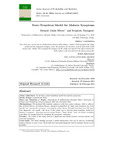| dc.contributor.author | Mbete, Drinold Aluda | |
| dc.contributor.author | Nyongesa, Kennedy | |
| dc.date.accessioned | 2021-12-31T08:21:15Z | |
| dc.date.available | 2021-12-31T08:21:15Z | |
| dc.date.issued | 2021-02-02 | |
| dc.identifier.uri | https://doi.org/10.9734/ajpas/2020/v10i430253 | |
| dc.identifier.uri | https://www.journalajpas.com/index.php/AJPAS/article/view/30253 | |
| dc.identifier.uri | http://ir-library.mmust.ac.ke:8080/xmlui/handle/123456789/1935 | |
| dc.description.abstract | Aims/ objectives: To develop a state-transition model for malaria symptoms. Study design: Longitudinal study.
Place and Duration of Study: Department of Mathematics Masinde Muliro University of Science and Technology between January 2015 and December 2015.
Methodology: We included 300 students (patients) with liver malaria disease, with or without the medical history of malaria disease, physical examination for signs and symptoms for both specific and non-specific symptom, investigation of the disease through laboratory test (BS test) and diagnostic test results. the focus of this study was to develop state-transition model for malaria symptoms. Bayesian method using Markov Chain Monte Carlo via Gibbs sampling algorithm was implemented for obtaining the parameter estimates.
Results: The results of the study showed a significant association between malaria disease and observed symptoms
Conclusion: The study findings provides a useful information that can be used for predicting malaria disease in areas where Blood slide test and rapid diagnostic test for malaria disease is not possible. | en_US |
| dc.language.iso | en | en_US |
| dc.publisher | Asian Journal of Probability and Statistics | en_US |
| dc.subject | State,Transition, Model, Malaria, Symptoms | en_US |
| dc.title | State-Transition Model for Malaria Symptoms | en_US |
| dc.type | Article | en_US |

